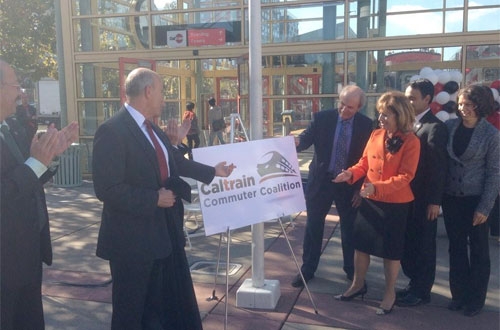Caltrain celebrates a decade of Baby Bullet service; coalition to coordinate funds for modernization
Written by Jenifer Nunez, assistant editor
As Caltrain marks its 10th year of Baby Bullet service, major employers that have grown their companies along the Caltrain/101 corridor announced the formation of a new advocacy coalition that will work to support efforts to expand Caltrain capacity and service as the system struggles to meet the unprecedented ridership and financial demands it's facing.
The Caltrain Commuter Coalition (C3) is being coordinated by the Bay Area Council (BAC), the Silicon Valley Leadership Group (SVLG) and the San Mateo County Economic Development Association (SAMCEDA) and includes participation from Bay Bio, Google, HP, LinkedIn, Oracle, Redwood City-San Mateo County Chamber of Commerce, San Francisco 49ers, San Francisco Chamber of Commerce, Stanford and other companies working to ensure that traffic congestion and limited public transportation capacity between San Francisco and San Jose does not limit the region’s ability to remain economically competitive.
In the decade since the first Baby Bullet express train made its way down the Caltrain corridor, the rail service has had an undeniable and substantial impact on the region’s commute patterns, land-use strategies, the decisions people make about where to live and work and the decisions business make about where to locate major facilities and how best to compete for top-notch employees.
“The Baby Bullet effect led to the unprecedented demand the railroad is now facing, pushing Caltrain’s ridership past the 61,000 average weekday rider mark just this past month,” said Tom Nolan, chair of the Peninsula Corridor Joint Powers Board, the three-agency partnership that owns and operates Caltrain. “For this reason, as Caltrain reflects on a decade of Baby Bullet service, we are also looking forward to Caltrain’s future.”
In the 10 years since the Baby Bullet trains were added to Caltrain’s schedule, average weekday ridership on the system has climbed from 23,947 passengers to more than 61,000 passengers, a staggering 150 percent increase.
Baby Bullet service has become so popular, that it now is dealing with the strains of its success. Caltrain is facing major capacity issues, with passengers squeezed into tight quarters during their morning and evening peak-hour commutes. Rapid ridership growth on the system is expected to continue and, by 2020, average weekday ridership is projected to be more than 70,000, a projection some regard as conservative.
Caltrain is working to provide some near-term capacity improvements by purchasing additional train cars that will allow for the operation of longer trains, but options for expanding diesel operations on the corridor are limited.
To address long-term needs, Caltrain is moving forward with the Caltrain Modernization Program, which will convert the system from a diesel-based service to one that operates high-performance electric trains. Electric trains will make the system cleaner and quieter and will help address growing ridership demand by increasing capacity and service frequency and reducing travel times compared to the existing diesel technology.
After converting to electric trains Caltrain plans to improve stations so that it can run longer trains, reduce dwell times and maximize the amount of capacity and service available to commuters.
Eventually, additional improvements will provide riders with even more options, including the accommodation of statewide high-speed rail service on the corridor and the extension of the system to the Transbay Transit Center being constructed in downtown San Francisco.
“We’re here to help make sure Caltrain realizes its potential,” said Jim Wunderman, President of the BAC, which helped coordinate the formation of the Caltrain Commuter Coalition. “Today, traffic congestion on the Highway101 corridor is threatening to limit the ability of our communities to thrive. Transforming Caltrain into a system that can sustain the long-term economic growth of our region is an essential part of the solution and we’re committed to helping make it happen.”





